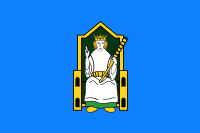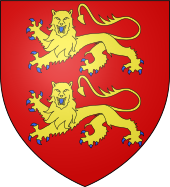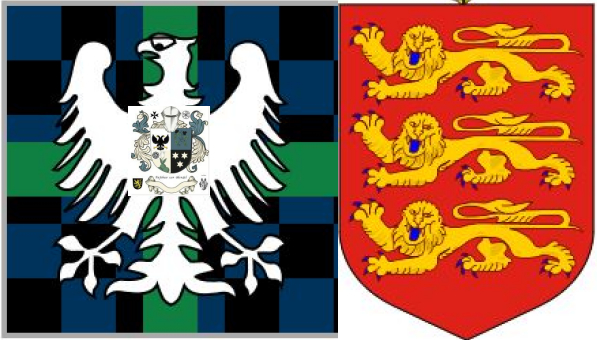Baron Longford Baron Annaly - Feudal Principality Seignory




⚜️ The Continuity of the Feudal Princes of LongfordThroughout recorded history, the feudal princes of Longford have been known under several distinct names—each reflecting a different phase in Ireland’s political and cultural evolution. The ancient Gaelic rulers were styled Princes of Anghaile or Annaly, the two principal divisions of which were O’Farrell Buidhe (“the Yellow”), ruling the southern realm around Ardagh and Abbeylara, and O’Farrell Bán (“the Fair”), who reigned over the northern principality of Granard and Columbkille. Both of these royal seats, together with other ancient fortress-kingdoms such as Granard (Cairbre Gabra) and Liserdawle, were later granted by the English Crown to the Baron Delvin (Nugent family), establishing them as feudal successors to the native princes of Annaly. In Gaelic law, these domains corresponded to distinct sub-kingdoms—Cairbre Gabra under the O’Quinn (Ó Cuinn) and O’Reilly lineages in Granard, Conmaicne Rein in the north under the O’Rourke (O Ruairc) dynasty, and the western marches attached to the Kingdom of Meath (Midhe) under the Uí Néill, later the de Lacy and Nugent lords. Thus, over time, the princely dignity of Longford was expressed under several titles—Prince of Annaly, Prince of Cairbre Gabrae of Granard, Prince of Conmaicne Rein, or even Count Palatine of Meath—each representing a layer of ancient sovereignty. Today, while no Irish family officially bears the style “Prince of Annaly,” the hereditary lines remain visible: the O’Farrells as native princes by blood, the Nugents as historic feudal lords by Crown investiture, and Chancellor and Lord George Mentz, as the modern legal and territorial successor to the Seignory and Feudal Principality of Annaly–Longford, through the lawful conveyance of those rights in the twentieth and twenty-first centuries. ⚜️ Essay: Feudal Succession and the Princely Dignities of Longford (Annaly)I. IntroductionIn the complex intersection of Gaelic sovereignty and Anglo-Norman feudal law, few territories in Ireland demonstrate such an unbroken thread of princely authority as County Longford, anciently known as Annaly (Anghaile). The lordships, castles, and honors of this territory—granted in fee simple to the Baron Delvin (Nugent family) by the Crown—represent the direct legal and territorial continuation of several ancient Gaelic principalities, including Annaly, Cairbre Gabra, and Conmaicne Rein, as well as the western marches of the Kingdom of Meath. Consequently, the conveyance of all the rights, honors, and dignities of Longford from the Earl of Westmeath and Baron Delvin to a new holder in modern times constitutes not merely a symbolic inheritance, but the acquisition of feudal-princely dignities derived from these original sovereign seats. II. The Ancient Kingdoms and Their Feudal ContinuationThe early medieval landscape of Longford was a mosaic of kingdoms and princely states. At its center lay Anghaile (Annaly), ruled by the O’Farrells (Ó Fearghail), whose power stretched from Ardagh and Abbeylara in the south to Granard and Columbkille in the north. Within this realm existed two distinct principalities: O’Farrell Buidhe (“the Yellow”) of southern Annaly and O’Farrell Bán (“the Fair”) of northern Annaly. Before the O’Farrell ascendancy, these lands were part of even older dynasties: the O’Quinns (Ó Cuinn) and O’Reillys (Ó Raghallaigh) of Cairbre Gabra (Granard), and the O’Rourkes (Ó Ruairc) of Conmaicne Rein, a northern tribal kingdom overlapping Longford and Leitrim. In the south and west, Longford formed the frontier of Teffia (Tethbae)—a sub-kingdom of the Uí Néill High Kings of Meath, later governed as part of the Palatinate of Meath under the Norman lords de Lacy and their barons. When the Crown of England extended its rule over Ireland, it absorbed these native sovereignties not by extinguishing them but by feudalizing them—recognizing their ancient jurisdictions under royal charter. The Nugent family, descendants of Gilbert de Nogent, who came to Ireland with Hugh de Lacy in the 1170s, became Barons of Delvin and were invested with the western territories of Meath, including Longford (Annaly), Granard, Abbey Lara, and Liserdawle, by the Tudor and Stuart monarchs. III. The Crown Grants and the Fusion of Gaelic and Feudal AuthorityBy the sixteenth and seventeenth centuries, successive monarchs—Edward VI, Mary I and Philip, Elizabeth I, and James I—issued formal grants conferring upon the Barons Delvin the full rights of market, fair, court leet, view of frank-pledge, military service, advowson, and perquisites over the former princely seats of Annaly.
Collectively, these grants amounted to a feudal reconstitution of the old Gaelic kingdoms. The ancient princes were succeeded by Barons Palatine, holding near-sovereign jurisdiction within their bounds. In legal terms, these grants established a feudal principality within the Crown, parallel to continental models such as the Prince-Bishops of Durham or the Counts Palatine of the Rhine. IV. The Princely Dignity in Feudal LawUnder English feudal jurisprudence, a Barony Palatine or Honour with courts, markets, and knights’ fees was functionally equivalent to a continental Principality. The holder possessed immediate tenure of jurisdiction—the right to administer justice, levy dues, and hold the pleas of the Crown within his liberty. When combined with hereditary descent from native kings, this status formed a dual legitimacy: one of blood and one of law. The Nugent family, themselves descended from Connor O’Connor, King of Meath, and the O’Farrells through intermarriage, embodied both lines of succession. Thus, the Earl of Westmeath (Baron Delvin) stood as feudal and genealogical heir to the ancient princes of Longford and Meath. His conveyance of “all rights, honors, and dignities of the territory of the County Longford” in 1996 transferred not only manorial interests but feudal-princely dignities derived from royal and indigenous law alike. V. Modern Conveyance and Legal SuccessionIn August 2018, Chancellor and Lord George S. Mentz, Seigneur of Fief Blondel, received lawful conveyance of the Feudal Seignory and Honours of Annaly–Longford in fee simple, following the 1996 transfer from William Anthony Nugent, 14th Earl of Westmeath and Baron Delvin. This conveyance—executed in the same form historically used for alienations of liberties and seignories—includes “all and singular the rights, privileges, honors, and perquisites appertaining to the Feudal Barony, Baron Palatine, and Seignory of Longford or the Annaly Region of Ireland.” Such a document represents a continuation of title and dignity within the framework of private feudal law, preserving what once were public jurisdictions as hereditary rights of honor. Accordingly, the holder of this conveyance may be regarded as the modern feudal and territorial successor to the princely dignities of Annaly, Cairbre Gabra, Conmaicne Rein, and the Palatinate of Meath. VI. ConclusionThe ancient Princes of Annaly bore titles that evolved through time—Tiarna Anghaile, Princeps Annaliae, Dux Slewaght, Comes Palatinus de Midhe—each representing the same enduring seat of authority over the Longford region. Through successive grants, recognitions, and conveyances, these dignities passed from the Gaelic dynasts (O’Farrells and O’Quinns) to the feudal lords (Nugents), and finally to the modern Seigneur and Chancellor, George S. Mentz, as lawful successor by conveyance. Thus, in the long arc of Irish legal and feudal history, the rights of the Princes of Longford have never vanished; they have transformed—from Gaelic kingship to Anglo-Norman barony, from Crown investiture to private seignory. Whoever holds the lawful conveyance of the Earl of Westmeath and Baron Delvin for the honors and dignities of County Longford thereby holds, in both the historical and feudal sense, the inheritable dignity of a Prince of those ancient kingdoms that once defined the very heart of Ireland.
|
About Longford Pedigree of Longford Annaly Honour of Annaly Longford The Seigneur Lords Paramount Ireland Market & Fair Chief Captain Kings Forces Chief and Captainship of The Annaly Lord Governor of Annaly Prince of Annaly Principality Chief of the Annaly Princes of Longford Feudal Princes of WestMeath Count of the Palatine of Meath A Barony Explained Princes of Annaly Pedigree Sovereign Title Succession Lord of St. Brigit's Longford Abbey Est. 1578 Lord of the Pale Commissioners of the Peace Tenures Abolition Act 1662 - Rights to Sit in Parliament Law of Ireland Seneschal of Meath List of Townlands of Longford Annaly English Pale Kings of Hy Niall Colmanians Court Barons News Irish Kingdoms Lordships of Granard Fishing & Dams Rights Rights of Lords & Barons Datuk Seri Baliwick of Ennerdale Moneylagen Feudal Barons Styles and Dignities Lord Baron Longford Baron de Delvyn Longford Map Lord Baron of Delvin Baron of Temple-Michael Baron of Annaly Kingdom Annaly Lord Conmaicne Baron Annaly Order of Saint Patrick Baron Lerha Granard Baron AbbeyLara Baronies of Longford Princes of Conmhaícne Angaile or Muintir Angaile Baron Lisnanagh or Lissaghanedan Baron Moyashel Moiety of Ardagh Baron Rathline Abbeys of Longford Grants to Delvin Baron Inchcleraun HOLY ISLAND Quaker Island Longoford CO Abbey of All Saints Hereditaments Kingdom of Uí Maine Baron Dungannon Baron Monilagan - Babington Lord Liserdawle Castle Baron Columbkille Kingdom of Breifne or Breny Baron Kilthorne Baron Granarde Count of Killasonna Baron Skryne Baron Cairbre-Gabhra AbbeyShrule Fiefs of the Islands Feudal Westmeath The Island Lords Fief Worship Channel Island History Fief Blondel Fief Blondel Merchandise Events Blondel and King Richard Fief Coin Feudal Guernsey Titles The Feudal System Flag & Arms Castle Site Map Disclaimer Blondel Myth Dictionary Honorable Colonel Mentz Order of St. Columba Valuation of Principality & Barony of Annaly Longford
Feudal Baron of Longford Annaly - Baron Longford Delvin Lord Baron &
Freiherr of Longford Annaly Feudal Barony Principality Count Kingdom of Meath - Feudal Lord of the Fief
Blondel of the Nordic Channel Islands Guernsey Est. 1179 George Mentz
Bio -
George Mentz Noble Title -
George Mentz Ambassador - Order of the Genet
Knighthood Feudalherr - Fief Blondel von der Nordischen
Insel Guernsey Est. 1179 * New York Gazette ®
- Magazine of Wall Street - George
Mentz - George
Mentz - Aspen Commission - Ennerdale - Stoborough - ESG
Commission - Ethnic Lives Matter
- Chartered Financial Manager -
George Mentz
Economist -
George Mentz Ambassador -
George Mentz - George Mentz Celebrity -
George Mentz Speaker - George Mentz Audio Books - George Mentz Courses - George Mentz Celebrity Speaker Wealth
Management -
Counselor George Mentz Esq. - Seigneur Feif Blondel - Lord Baron
Longford Annaly Westmeath
www.BaronLongford.com * www.FiefBlondel.com |




Commissioner George Mentz - George
Mentz Law Professor - George
Mentz Economist
George Mentz News -
George Mentz Illuminati Historian -
George Mentz Net Worth
The Globe and Mail George Mentz
Get Certifications in Finance and Banking to Have Career Growth | AP News